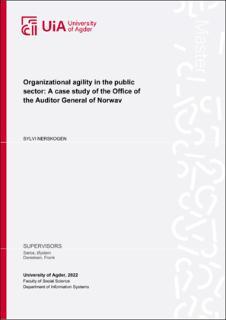| dc.description.abstract | This master thesis explores organizational agility in the public sector through a case study of a
state agency. Organizational agility is as a learned, permanently-available dynamic capability
that can be performed quickly and efficiently to the degree necessary, and whenever needed, to
increase business performance in a volatile market environment. Although the definition
includes a focus on a volatile market environment and business performance, many public
organizations strive for agility. This master thesis investigates whether the concept of
organizational agility could be a good fit for the public sector, even without obvious competitors
and profit focus. A literature review was conducted to get an overview of previous research on
organizational agility within the public sector. This resulted in a conceptual model, which forms
the theoretical lens for this study. The model includes three main elements: drivers (external
and internal), organizational agility (agility enablers and agile capabilities) and organizational
performance. The topic is explored through a case study of the Office of the Auditor General
of Norway (OAGN) and their innovation lab. The research question is: How can an innovation
lab influence organizational agility the public sector? Ten semi-structured interviews were
conducted, and eight meetings were observed by the researcher. Strategic documents were
analyzed to obtain an understanding of organizational performance. The empirical results show
both external and internal agility drivers in the OAGN. The study identified some challenges in
the organization, such as the organizational culture, communication style, the availability of
technology, the development of competence for the future, and autonomy versus alignment.
The challenges are mapped to the agile capabilities suggested by previous research.
Competence, flexibility and courage are identified capabilities in the innovation lab. The
innovation lab has indeed increased the organization’s awareness about new technology trends,
which is seen as the sensing part of the responsiveness capability. The innovation lab improves
the organization’s ability to pursue possibilities provided by new technology. Although, being
agile is not the goal, a holistic view of agility can help organizations reach their strategic goals
and the social mission. Measuring and monitoring the performance provide management with
the necessary insight to adjust the enablers and improve the capabilities to tackle changes in the
organization’s environment. This study provides insight into practice and can be of inspiration
for other state agencies striving for agility. An adjusted conceptual model for organizational
agility in the public sector is suggested. The model should be challenged and further tested in
other cases and through other research approaches.
Key words: organizational agility, public sector, audit, innovation lab | |
